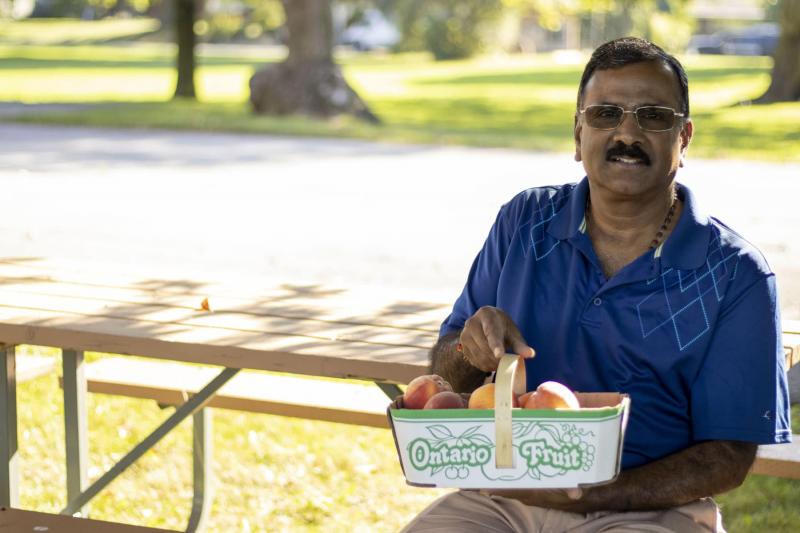Dr. Jay Subramanian Featured in Niagara Now
Overview:
Somer Slobodian
Local Journalism Initiative Reporter - Niagara Now
September 6, 2023
New types of peaches are allowing farmers to start the peach season earlier, get more fruit into more homes faster and give people new produce to sink their teeth into.
Thanks to new varieties such as early blush and rising sun, Kai Wiens, a Niagara-on-the-Lake tender fruit farmer, was among those who harvested tasty peaches as early as July 5 this year — his earliest harvest ever. “With new, earlier varieties now on stream, we are supplying the Ontario market sooner than before,” Wiens told The Lake Report via a social media message
Sarah Marshall, board chair of Ontario Tender Fruit, said July 5 is even earlier than when the golden plums are ready, “which is typically thought to be the first thing that really gets harvested.” Ontario Tender Fruit works with the Vineland Research & Innovation Centre, which breeds new tender fruit varieties, to bring new varieties to Ontario farmers.
There is a demand in Niagara and across Canada for varieties that are ready earlier, said Jayasankar Subramanian, a professor of tree fruit breeding and biotechnology at the University of Guelph. He’s based at the Vineland centre and has been breeding tree fruit varieties for about 22 years.
Niagara is in the northernmost latitude of peach growing, and peaches grown in places such as Georgia or California won’t grow here due to Niagara’s climate, he said. The breeding program was created to offer new varieties that would grow and thrive in Niagara. “One of the major objectives that I put in my breeding program is to get varieties that are earlier than what is available, so that we get that earlier advantage in the market,” he said.
The research facility specializes in developing new fruit and vegetable varieties that fight diseases, are better prepared to withstand extreme weather brought on by climate change and can extend and begin growing seasons earlier. “Any variety that we release should have a baseline disease resistance for brown rot and bacterial spot,” said Subramanian. These are common diseases found on stone fruits like peaches and nectarines.
Throughout the last eight years, he’s helped release three new varieties — early blush, rising sun and vee blush. “Early blush is the earliest ripening variety that we know of,” said Marshall. Wiens added the varieties that are ready earlier allows “for a longer employment period” for the employees who package the fruits.
Such varieties not only help farmers get a head start on the peach season, Marshall said, but also helps to reduce imported fruit and increase revenue for farmers. “If we’re in the market earlier than we can try to limit the amount of imports that are coming in,” she said. Subramanian added that peaches taste better when eaten as quickly as possible, so the earlier the crop, the faster they’ll get onto tables and the less residents have to rely on older, imported peaches. She said new varieties can also help extend the growing season, which would provide more revenue for farmers over a longer period of time.
However, from first developing a variety to the time it gets into the hands of a consumer is not a fast process — in fact, it’s the complete opposite. “It takes almost a lifetime,” Subramanian said. “Any tree fruit from start to finish will take an average of let’s say 20 to 25 years,” he added. The peach variety early blush was in the works since 1997 and didn’t become available to growers until two years ago. “This is a very patient and slow process and you have to be lucky at many steps to get the right varieties out,” he said. He added that it’s very rare they get something they can release within 15 years. However, it’s a good feeling for a peach breeder when they finally see the varieties they’ve worked on for multiple years hit the markets, he said.
Subramanian said everyone is involved throughout the process on a tender fruit evaluation committee — this includes growers, packers, representatives from the Vineland research centre, people from the marketing board and nurseries.
He will give a tour to committee members and show them the peach selections that are ripened, and the members will provide their comments and input. He said he also provides technical inputs to Marshall, who coordinates the process. Marshall said the committee looks things like the earliness of the peach and things that might extend the peach season. Subramanian said everybody is involved so that “when it is released, everyone knows what they are getting exactly.”
Chosen varieties will go through multiple stages, including a three year test stage. “Because we want to make sure that what you see in one year is consistent to the next year,” said Marshall. If it’s not a dud, she said, the variety will be sent to British Columbia where it’ll be treated for diseases. This could take more than three years. Eventually, the variety will also be tested in a grower setting to make sure it does well.
The next variety of peach Subramanian is working on will be targeted at generation Z and millennials, he said. He said that group isn’t fond of biting into a soft, juicy peach and getting messy — so he’s looking to fix that. It’s known as the neat peach, which would be firm and crisp on the outside, but juicy on the inside. It won’t be ready for seven to 10 years, he said, but that’s the type of peach that consumers can expect in the future.
